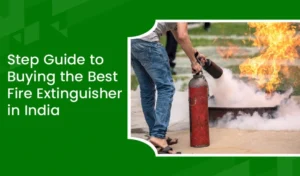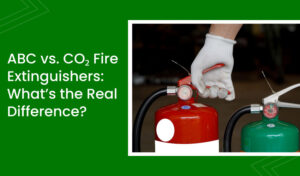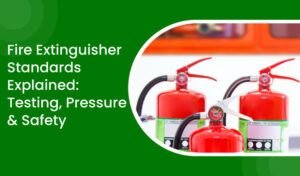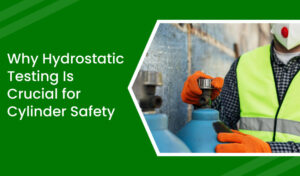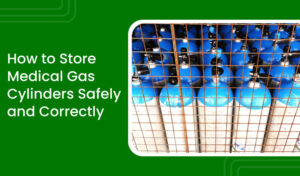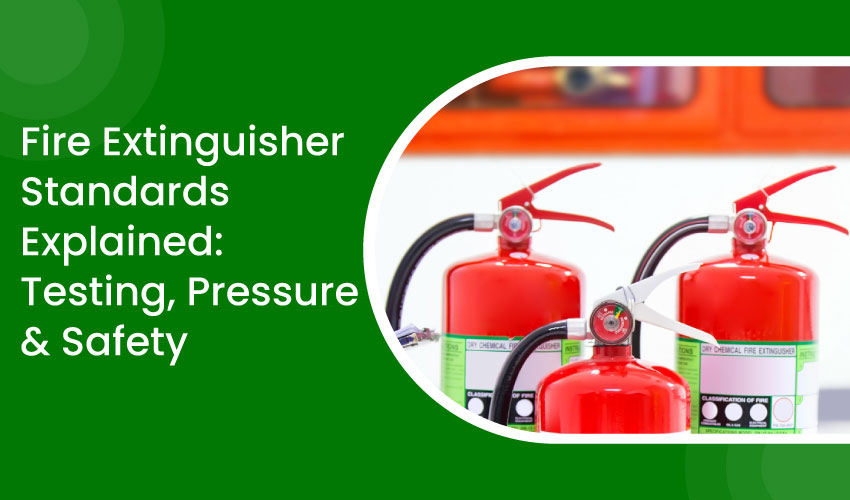
Fire extinguishers are life-saving devices used to extinguish fires. Given the importance of this device, fire safety agencies have set various mandatory guidelines to maintain the performance and safety of the firefighting cylinder. In this detailed blog post, we will guide you through the regulatory standards, mandated testing methods, when and what to check, as well as compliance mistakes to avoid. Keep reading!
A] Fire Extinguisher Cylinder Standards: What Do They Cover?
The safety of fire extinguishers is governed by the BIS (Bureau of Indian Standards), ensuring only safe and reliable firefighting cylinders are sold or used. The established standards provide guidelines for performance, construction, and safety requirements for various types of fire-extinguishers. The guidelines outlined in these standards are applied across all types, be it water-based, foam-based, dry powder, carbon dioxide, clean agents, or water mist. Moreover, these standards ensure that fire extinguishers undergo rigorous testing methods, inspection is performed at intervals, and manufacturers and sellers follow the mandated compliance..
Looking for robust, compliance-ready, and tested across national and international safety standards, fire-fighting cylinders
B] Fire Extinguisher Testing Methods: How Performance and Safety Are Verified?
1. Hydrostatic Testing
BIS standards mandate performing hydrostatic testing on every fire extinguisher at 5-year intervals. Hydrostatic testing involves pressurising the cylinder with water up to a specific level, usually more than the working pressure. After pressurisation, any indication of leaks, cracks, or other defects is observed. This testing method ensures the structural integrity of the cylinder and verifies whether the cylinder is capable of further use.
2. Visual Inspections
BIS mandates the routine visual inspection of fire extinguisher cylinders to ensure they are free from visual defects and ready to use in a time of fire. The visual testing of a fire extinguisher includes checking for cracks, corrosion, and weld defects.
3. Valve & Thread Testing
valve and thread testing to ensure every cylinder is structurally intact. This testing procedure is done by evacuating the fire extinguisher agent and checking the valve and threads thoroughly. This test also includes checking the safety pin, tamper seal, and nozzle. If any discrepancies are found, repairing or removing from the services is stated in the standards. Also, checking pressure handling capacity and nozzle connection reliability periodically, even if unused, is mandated.
C] Fire Extinguisher Inspections: What to Check and When
standard mandates periodic maintenance of the fire extinguisher. Below are the periodic maintenance schedules and what they should cover.
1. Monthly Checks (In-House)
Every fire extinguisher must undergo monthly checks, involving assessing external conditions and checking for any rust, dents, and damage. Every cylinder should be checked for the safety pin, tamper seal, and labelling visibility every month. Hose and nozzle condition should also be checked every month.
2. Annual Inspections (By Trained Technicians)
The standard also directs that fire extinguisher cylinders should undergo annual inspections only by trained technicians. It should include inspecting internal conditions, discharge hose integrity, and repressurisation or refilling (if needed).
3. Pressure Gauge Check
BIS standards also mandate a pressure gauge check, which includes ensuring the needle is in the green zone. If it is in the red zone, whether low or high, the extinguisher is not safe for use. The cylinder needs replacing or recharging.
D] Common Compliance Mistakes to Avoid
1. Skipping Scheduled Testing or Re-Certification
Skipping scheduled testing or recertification is a common compliance mistake that leads to heavy fines and even major safety hazards. To avoid these consequences, set monthly and annual inspection schedules and have the fire extinguisher tested thoroughly by a trained technician. Also, ensure you keep a log of all the maintenance done to mitigate compliance issues and safety hazards.
2. Ignoring Pressure Irregularities
Ignoring pressure irregularities is another safety hazard that often goes overlooked until a fire emergency occurs. It also results in legal consequences, as keeping the fire extinguisher’s pressure in the green zone is mandated by the respective authorities. Gauges in the red zone are considered faulty or require refilling. So, ensure the needle of the pressure gauge always stays in the green zone to mitigate the extinguisher’s failure when a fire emergency occurs.
3. Using Non-Certified Refill Services
Using non-certified refilling services may lead to improper charging, wrong agent filling, or integration of counterfeit parts. You should always use only professional and certified agencies for refill services. It mitigates the chances of device failure, and you get the original agents and proper filling with them, which ensures the device’s workability at the time of use.
4. Installing the Wrong Type of Extinguisher
Installing the wrong type of extinguisher at a place where the installed fire cylinder is ineffective can lead to dangerous fire consequences. For instance, using a water extinguisher near electrical sources can be dangerous. So, ensure you place the right type of fire extinguisher based on the fire types the place is likely to encounter.
Looking for robust, compliance-ready, and tested across national and international safety standards, fire-fighting cylinders
Conclusion
Fire extinguishers are a very useful device that helps extinguish fire situations and save lives and property. Given the importance of this device, Indian and international fire safety agencies have set the strictest standards that must be followed by the manufacturers and users. Follow the above-outlined methods and avoid mistakes to save your premises and people from fire emergencies.
If you are looking for robust, compliance-ready, and tested across national and international safety standards firefighting cylinders, Rama Cylinders is here to help you. We are the largest CNG cylinder manufacturers in India, known for offering cost-effective and extremely safe fire extinguisher cylinders. Contact us today!
FAQs
In India, fire extinguishers are regulated by the Indian Standards (IS) under the standard regulations. These standard regulations cover design, pressure ratings, and testing for the performance and safety of fire extinguishers.
Every fire extinguisher should be tested monthly and annually. Every firefighting cylinder must undergo hydrostatic testing every 5 years. These periodic tests keep the cylinders intact and compliance-ready.
The hydrotesting of fire extinguisher cylinders is a detailed testing procedure, which utilises water to check the structural integrity of the cylinder. In this testing procedure, the cylinder is pressurised with water beyond the working pressure and checked for leaks, cracks, or physical deformations.
Every fire extinguisher in India should have the Bureau of Indian Standards (BIS) certification. It includes the guidelines that issue for ensuring the cylinder’s safety, performance, and reliability.
No, it is not advised to use expired or untested fire extinguisher cylinders, as they are not reliable and may not work or pose safety risks in a fire emergency. So, ensure to install only unexpired and thoroughly tested fire extinguisher cylinders to ensure their workability when needed.
